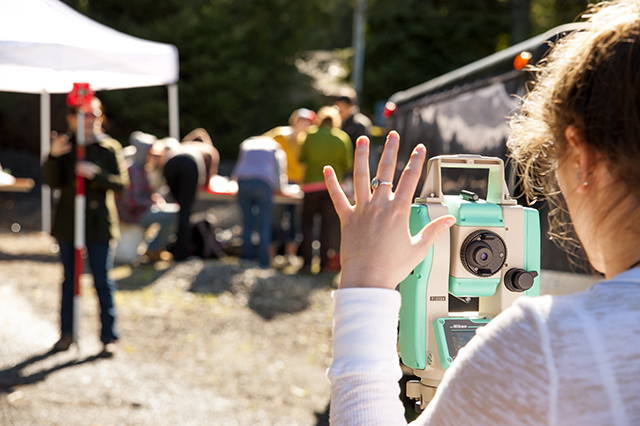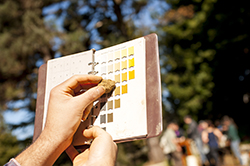
The exercise was part of a simulated archaeology dig organized by anthropology professor Marisol Cortes-Rincon. Located at the corner of 16th and Spring streets on campus, the dig is designed to teach students archaeology field methods and prepare them for careers in anthropology, geography, Native American studies and environmental education and interpretation.
“This is the type of project you mainly find at large research institutions, so to have the opportunity to give our students this hands-on learning experience is huge,” says Cortes-Rincon.
Developed in cooperation with Plant Ops, the site consists of manmade pits divided into layers. The layers consist of authentic historic artifacts and manmade prehistoric items. They include medicine vials, animal bones, wood beams and sod insulation mimicking a historic house.
Over the new few years, anthropology students will use field methods to uncover the layers, then collect and catalog the artifacts they find. Later, they’ll use identifying techniques to date and analyze the items and draw conclusions about the simulated communities that lived there.

Among the skills they’ll walk away with: excavation, mapping, soil sampling, spatial analysis, artifact processing, site identification, interpretation and statistical analysis, Cortes-Rincon says. It’s the type of hands-on experience that’s highly valuable for graduate school and careers in the social sciences.
“There’s currently no place on the North Coast where students can receive this kind of training without endangering sensitive sites,” Cortes-Rincon says.
The dig also includes an educational outreach component. As part of that program, HSU students will lead archaeology workshops for elementary and middle schoolers at the Natural History Museum. Classes can also take field trips to the excavation site.
Local Native American communities interested in historic and cultural preservation will have the opportunity to use the site for training purposes as well, Cortes-Rincon explains. “We expect it be a valuable resource not only for our students and local schools but also for tribal monitors interested in proper field techniques,” she says.
The simulated archaeology dig was made possible through family and alumni gifts to the Humboldt Loyalty Fund, and the Parent & Family Fund, which support projects that enhance the student learning experience.
For more information, visit humboldt.edu/giving.